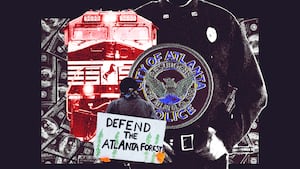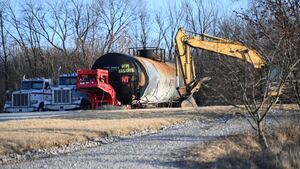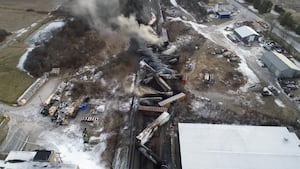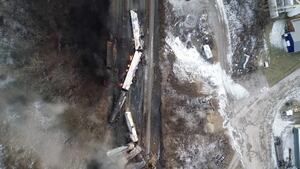After the catastrophic Norfolk Southern train derailment in East Palestine, Ohio, it didn’t take long for the supercharged partisan atmosphere in Washington to morph the disaster into a political blame game.
Republicans castigated President Joe Biden’s administration for falling asleep at the switch. Biden officials pointed to deregulation under former President Donald Trump. And all the while, the rail industry knew that, even though new safety regulations would seem like an obvious response to the crash and subsequent release of toxic chemicals into the air, new regulations were far from a given.
Although it’s far from the most influential lobby in Washington, the rail industry has spent more than $700 million in the last 25 years, according to data maintained by OpenSecrets. And it’s those hundreds of millions spent pushing back against government safety regulations—primarily but not exclusively through Republicans—that has purchased considerable influence in the U.S. Capitol.
A review by The Daily Beast of lobbying and campaign finance filings tells a story of a decades-long ideological push and pull. The review shows that, while it’s sometimes difficult to draw straight lines between an acute event and its cause, entrenched corporate and political cultures still have an overwhelming influence.
For instance, one major requirement now on the books—an automated braking technology called “positive train control” (PTC)—debuted on the National Transportation Safety Board’s “most wanted” list in 1990. But under industry pressure, PTC wasn’t fully implemented for 30 years.
As the dust, debris, and various poisons settle from this Norfolk Southern crash, it appears the Trump administration’s specific anti-regulatory moves may not be directly responsible for the wreck, which the National Transportation Safety Bureau’s preliminary report blamed on an overheated wheel bearing.
But that finding itself doesn’t necessarily shift the blame back to Biden. In fact, it puts more pressure on Republicans to do something they’ve resisted for years—expand rail safety regulations, such as updating outdated track detection technology.
That’s perhaps the most profound revelation to emerge from the financial data: meaningful changes are almost always reactive, in response to catastrophes instead of anticipating and preventing them before they happen.
In the wake of the crash, federal regulators disclosed that there have been five similar derailments since 2021, two involving Norfolk Southern, the American Journal of Transportation reported on Thursday. The article also said that current track monitoring relies on “antiquated technology” with “a mixed record of preventing accidents.”
But it’s difficult to rein in an industry that’s as vital to everyday American life as railroads are, let alone convince the industry to support forward-looking regulations that would eat into its bottom line. It’s hard to overstate the leverage that this special interest group wields—if railroads stop working, America stops eating.
And yet, the railroad industry’s culture of resistance is most immediately and easily identified in the money.
Over the years, the industry has poured hundreds of millions of dollars into blocking and stalling new rules and legislation, including measures designed to strengthen and modernize rail safety. But a side-by-side comparison of rail lobby spending and government action also suggests that money alone doesn’t explain everything. Instead, the larger baked-in political ideology of the governing party appears to have carried the day on key issues.
This is reflected in the fact that the rail industry’s lobbying expenditures soared under Barack Obama—most specifically his first term—and then fell, most notably after Obama unilaterally enacted key safety regulations in 2015. The spending stayed at those same lower levels after Trump took office, and have continued at that rate under Biden.
According to OpenSecrets data, the railroad industry shelled out nearly $185 million on lobbying during Obama’s first four years. During Trump’s one term in office, that spending totaled around $107 million. (Rail lobbying during Obama’s second term was about $127 million, according to OpenSecrets.) And railroad lobbyists are far more likely to have direct connections to Capitol Hill than almost any other group
Filings further show that the money was largely aimed at blocking government regulation.
The Association of American Railroads—the industry’s top lobbying group—spent heavily to push back against safety, labor, and antitrust proposals during the Obama years, according to an OpenSecrets database of lobbying disclosures. Under Trump, the partisan winds became friendlier, and spending tailed off.
While Obama didn’t exactly stick it to the railroads—his early visions of overarching antitrust and labor reforms never came to fruition—he did use his executive power to impose some key safety regulations in the face of all that cash. But Trump quickly scrapped those rules with the stroke of a Sharpie, and the railroad companies apparently didn’t feel they had to kick up their spending to convince him and his allies to act in their favor.
That’s not to say they stopped spending. Lobbyists know they have to maintain their relevance, and over Trump’s term, the rail lobby—led by AAR—spent millions of dollars renting the ears of lawmakers.
Many of those expenses went to combat the Safe Freight Act. That bill would have enshrined the two-member crew minimum into law, and was introduced in 2017 by a Republican—the late Rep. Don Young of Alaska, who’s the longest serving Republican in Congress of all time.
Norfolk Southern alone spent about $4.5 million on lobbying between 2017 and 2018, according to the company’s federal lobbying disclosures.
A Norfolk Southern representative referred The Daily Beast to “our extensive Government Relations’ Political Activity and Political Contributions overview” and their statement on the NTSB findings.
“We are taking further actions to improve the safety processes and technology we currently have in place while we await the final results of the NTSB investigation,” the representative said, pointing to $1 billion annual investments in safety technology, equipment, and infrastructure and several corporate commitments.
Asked for comment, an AAR spokesperson sent a 228-word statement saying that “any assertion that railroads broadly opposed increased safety regulations is patently false,” pointing to a “a long, consistent record.” The spokesperson gave one concrete example, “pushing the Department of Transportation” in 2015 to raise standards for tank cars carrying flammable liquids, including a petition on the matter to the Pipeline and Hazardous Materials Safety Administration. (Those negotiations were more nuanced, according to the DOT’s final rulemaking and the PHMSA’s response to the petition.)
The statement also directed The Daily Beast to the AAR’s statement this week on newly released Federal Railroad Administration safety data, and touted “$20 billion in annual private investments” towards broadly “maintaining the network” and “deploying technology to enhance safety.”
When Trump landed in the White House, he quickly tanked several of the targeted Obama policies. One rule—which briefly came back into the news after the Norfolk Southern derailment—mandated new brake technology for trains carrying volatile and hazardous materials. Trump also killed a rail safety audit program, along with another proposed Obama rule requiring trains to operate with two-man crews, which had already begun to languish. Those repeals and others under Trump appear either minimally or entirely unrelated to the Norfolk Southern derailment, according to a Washington Post fact check.
Generally speaking, the rail industry’s political giving has always favored the GOP. According to OpenSecrets, the industry has spent about $108.6 million to influence elections since 1990, with PACs giving more than individual employees.
Republicans have received the majority of those donations in every election, with two exceptions—the 1990 and 2010 midterms. And some of the recent top GOP recipients, such as Sens. Sam Graves, Jerry Moran, and John Thune, hold leadership positions with influence over that industry.
Contributions from Norfolk Southern employees and its corporate PAC have also historically curved towards Republicans, the data shows, though the company favored Democratic candidates in both 2020 and 2022.
In one curious case, the money went the other way.
Between 2017 and 2021, then-Sen. Roy Blunt (R-MO) rented office space from Norfolk Southern for both his campaign committee and leadership PAC, FEC records show. Over that period, Blunt’s committees paid Norfolk Southern approximately $76,000 in rent. (In 2015, Blunt introduced a bill with bipartisan co-sponsors that would extend the deadline for adopting PTC.)
Still, it’s clear that Obama’s actions—no matter how debatable their relevance to the Norfolk Southern disaster, or the Democrats’ failure to deliver on antitrust issues—appear to have overcome an onslaught of cash. But he and liberal allies also weren’t able to rally enough support to fully overcome Republican and industry resistance.
It’s instructive to note that the anti-regulatory lobbying push actually started the year before Obama took office, under a Republican administration.
That year, the railroad industry spent almost $43 million lobbying inside the beltway as Congress negotiated the bipartisan Rail Safety Improvement Act of 2008, which introduced positive train control. President George W. Bush signed it into law that October.
But the pendulum quickly swung the other way.
After the RSIA was passed, the industry dug in hard against some of those new rules, including the PTC requirement, which at that point had already been on the government’s wishlist for 18 years.
Over the next several years, the rail lobby successfully convinced lawmakers on both sides of the aisle to delay the mandate, citing cost and time constraints.
Obama himself signed a bill delaying PTC in 2015—the same year he put forward the new braking requirement that Trump tossed—and the rule was only fully adopted at the end of 2020.
The biggest revelation in the data is still not about money’s effect on the speed of progress, or even partisanship per se. Again, it’s that the most significant advancements are almost never proactive. Industry interests are powerful, and it takes a catastrophe like East Palestine to sharpen the focus on safety.
For instance, the RSIA of 2008, with its long-awaited PTC mandate, came only after a commuter train collision in Southern California killed 25 people. At the time, the Association of American Railroads put out a press release backing the bill. But according to the Internet Archive, the page disappeared from the organization’s website sometime between 2012 and 2013.
Around that same time, the industry convinced the Obama administration to extend the timeline for the PTC rule. Three years later, however, a fatal Philadelphia Amtrak wreck brought rail safety front and center again. In response, Obama enacted federal regulations without the help of Congress, while agreeing to delay PTC. The next year, however, another deadly passenger train crash put the heat back on the railroad lobby.
The Norfolk Southern freighter that derailed last month had positive train control. According to the NTSB’s preliminary report, the train’s PTC system was not to blame, as it was “enabled and operating at the time of the derailment.”
That’s put a new albeit reactive focus on another safety mechanism: old detection technology that may not be up for the task.
At a press conference addressing the report, NTSB chair Jennifer Homendy told reporters that track monitoring is “something we have to look at.”
“Roller bearings fail,” Homendy said. “But it’s absolutely critical for problems to be identified and addressed early so these aren’t run until failure.”










